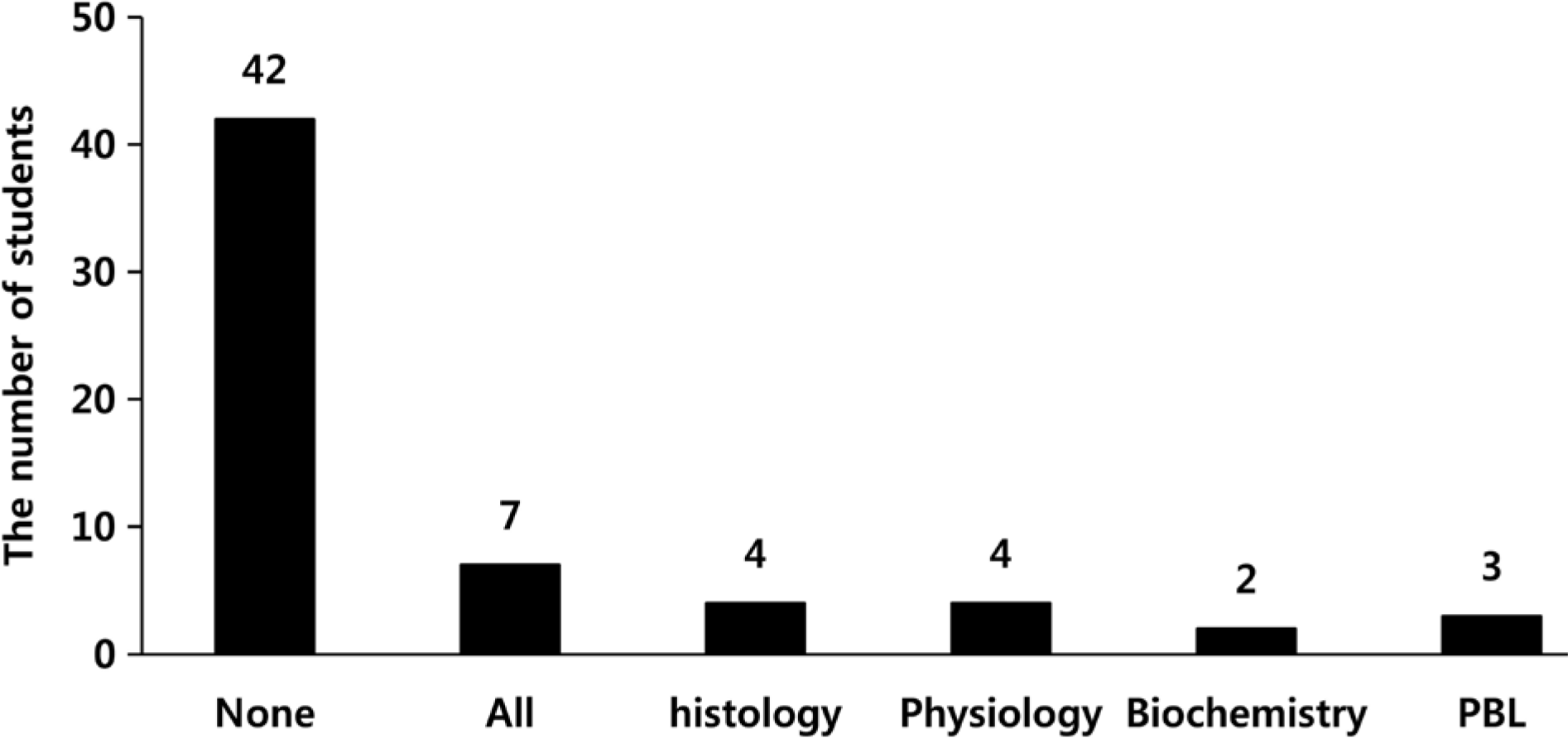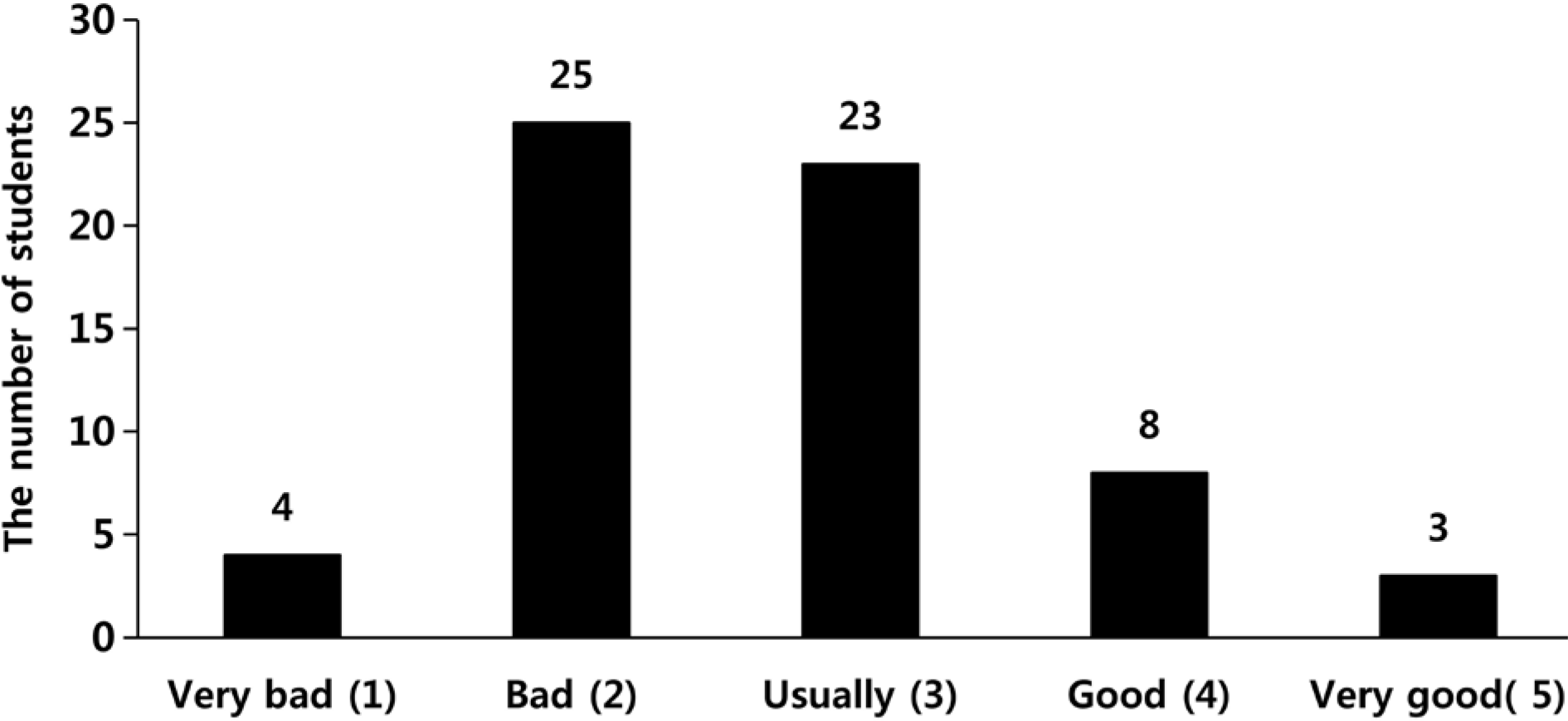Abstract
Peer review in dissection is a good evaluation method that allows students not only to recognize professional behavior of peers, but also to look back on themselves. The purpose of this study is to analyze the recognition and feelings of students about peer review in dissection and to use peer review more effectively. In this study, it was to examine the reflection on grades of peer review, the improvement on attitude of dissection by peer review, and the reliability of peer review, also, additionally necessary subjects, the method of peer review, the emotions of students during the peer review. As a result of the questionnaire survey, the necessity about reflection of peer review (48, 67.6%), the improvement on attitude of dissection (41, 57.7%) and the reliability of peer review (30, 44.1%) were positive. Moreover, many students asked additionally necessary subjects not to be required except for anatomy (42, 67.7%). In the questionnaire on the method of peer review, to select students who have been good and bad in the practice is best (34 students, 57.6%). In the questionnaire for emotions of students during the peer review, “bad” was the most common (25, 39.7%), and the average value was about 2.7 in the 5 scale. There is a limitation to utilize peer review as an evaluation method of anatomy education. Therefore, much more effort is needed to improve the utilization of peer review and the professor should support the emotions of students during the peer review.
Go to : 
References
1. Hong HJ, Yoon SP. The relationship between academic achievements and curricular changes on anatomy based on basic medical education examination. Korean J Phys Anthropol. 2016; 29:105–12.

2. Choi GY, Kim JM, Seo JH, Sohn HJ. Becoming a doctor through learning anatomy-narrative analysis of the educational experience. Korean J Phys Anthropol. 2009; 22:213–24.
3. Smith SF, Mathias HS. What impact does anatomy education have on clinical practice? Clin Anat. 2011; 24:113–9.

4. Ward PJ, Walker JJ. The influence of study methods and knowledge processing on academic success and longterm recall of anatomy learning by first-year veterinary students. Anat Sci Educ. 2008; 1:68–74.

5. Oh SA, Chung EK, Rhee JA, Baik YH. An evaluation of integrated curriculum based on students'perspective. Korean J Med Educ. 2007; 19:305–11.
6. Sugand K, Abrahams P, Khurana A. The anatomy of anatomy: a review for its modernization. Anat Sci Educ. 2010; 3:83–93.

7. Kim H, Shin D. Representation method of info graphic image telling – Focusing on the peirce's semiotics. Semiotic Inquiry. 2014; 39:403–38.
8. Arnold L, Shue CK, Kritt B, Ginsburg S, Stern DT. Medical students'views on peer assessment of professionalism. J Gen Intern Med. 2005; 20:819–24.
9. Camp CL, Gregory JK, Lachman N, Chen LP, Juskewitch JE, Pawlina W. Comparative efficacy of group and individual feedback in gross anatomy for promoting medical student professionalism. Anat Sci Educ. 2010; 3:64–72.

10. Bryan RE, Krych AJ, Carmichael SW, Viggiano TR, Pawlina W. Assessing professionalism in early medical education: Experience with peer evaluation and self-evaluation in the gross anatomy course. Ann Acad Med Sing. 2005; 34:486–91.
12. Kam BS, Kim MJ, Joo SI, Yune SJ, Im SJ, Lee SY, et al. Relationship of peer- and self assessments in the anatomy laboratory and academic performance of gross anatomy. Korean J Phys Anthropol. 2018; 31:1–7.

13. Ferris H, O'Flynn D. Assessment in medical education: What are we trying to achieve? Int J Higher Educ. 2015; 4:139–44.

14. Swick HM, Szenas P, Danoff D, Whitcomb ME. Teaching professionalism in undergraduate medical education. JAMA. 1999; 282:830–2.

15. Cruess RL, Cruess SR. Expectations and obligations: Professionalism and medicine'social contract with society. Perspect Biol Med. 2008; 51:579–98.
16. Eva KW. Assessing tutorial-based assessment. Adv Health Sci Educ. 2001; 6:243–57.
17. Heylings DJ, Stefani LAJ. Peer assessment feedback marking in a large medical anatomy class. Med Educ. 1997; 31:281–6.

18. Magzoub ME, Schmidt HG, Dolmans D. Assessing students in community settings: the role of peer evaluation. Adv Health Sci Educ Theory Pract. 1998; 3:3–13.
19. Greenbaum DS, Hoban JD. Teaching peer review at Michigan State University. J Med Educ. 1976; 51:392–5.

20. Van Rosendaal GM, Jennett PA. Comparing peer and faculty evaluations in an internal medicine residency. Acad Med. 1994; 69:299–303.

Go to : 
Table 1.
The results of the questionnaire survey about the reflection on grades, the improvement on the attitude of dissection, and the reliability




 PDF
PDF ePub
ePub Citation
Citation Print
Print




 XML Download
XML Download